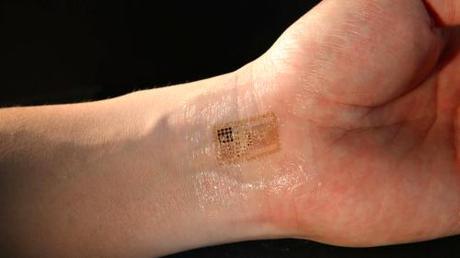“And he causeth all, both small and great, rich and poor, free and bond, to receive a mark in their right hand, or in their foreheads.” -Revelation 13:16
Dictionary definition of “tattoo”:
n. pl. tat·toos
1. A permanent mark or design made on the skin by a process of pricking and ingraining an indelible pigment or by raising scars.
2. A design made on the skin with a temporary dye such as henna or ink.

The International Business Times reports, Aug. 14, 2011, that an international team of researchers from the United States, China and Singapore had developed a micro-electronics technology, called an epidermal electronic system (EES), that could revolutionize medical sensing, computer gaming and even render the super slick James Bond movie gadgets antiquated.
As described in the journal Science and reported by the Associated Press, EES is like an “electronic tattoo” — a super-thin “skin-patch” that mounts onto the skin like a temporary tattoo, containing an array of electronic components that allows researchers to track key vital signs from patients. The patches are already able to monitor the heart, various other muscles and brain activity.
The study’s co-author John Rogers, a professor in materials science and engineering at the University of Illinois at Urbana-Champaign, said, “It’s a technology that blurs the distinction between electronics and biology. Our goal was to develop an electronic technology that could integrate with the skin in a way that is mechanically and physiologically invisible to the user.”
The wireless device is small and nearly weightless. It is less than 50 micrometres thick – less than the diameter of a human hair. There are also tiny solar cells that can generate power or get energy from electromagnetic radiation.
The device doesn’t use any adhesive to adhere to the skin. The sensor is mounted on to a water-soluble sheet of plastic, and is attached to the body by brushing with water, just like a temporary tattoo. It relies on a weak force called the van der Waals force, which causes molecules and surfaces to stick together without interfering with motion. This is the same force with which geckos stick to walls.
One of the disadvantages is that since the skin constantly produces new cells, the surface cells die and are brushed off, meaning a new sensor would need to be attached at least every fortnight.
Here are some anticipated uses for the EES electronic tattoo:
- To replace the bulky equipment — of cables, wires, gel-coated sticky pads and monitors — currently used in hospitals to keep track of a patient’s vital signs. The researchers say the bulky equipment could be “distressing” for patients with heart problems who must wear a bulky monitor for a month “in order to capture abnormal but rare cardiac events”.
- To monitor premature babies.
- To study patients with sleep apnea without them wearing wires through the night.
- To make electronic bandages to help skin heal from wounds and burns.
- For patients who suffer from certain diseases of the larynx. When the EES tattoo was attached to the throat it allowed users to operate a voice-activated video game with better than 90% percent accuracy.
- Rogers also said the EES “could also form the basis of a sub-vocal communication capability, suitable for covert or other uses” – whatever that means.
Gosh, the possibilities are endless!
All the more reason why everyone, all over the world, must have this super-duper electronic tattoo, erh, mark. [Snark]
~Eowyn

